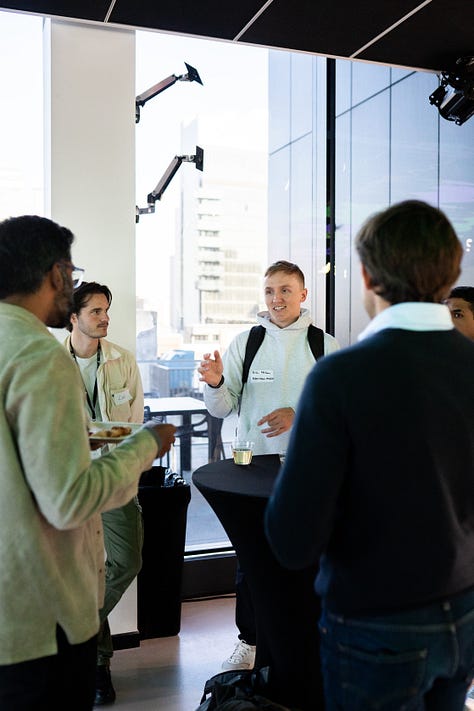Building the Future of Social with Farcaster and Solana
Highlights from our panel on public social graphs, onchain monetization, and bridging web3 ecosystems.
Last week, we had the privilege of hosting a special FarCon side event featuring Solana and the Farcaster team, including co-founder Dan Romero. The session sparked some interesting conversations about the intersection of social networks, blockchains, and the future of public social infrastructure. Here's a recap of the key insights shared.
Social Graphs as Public Infrastructure
One of the themes that emerged was Tapestry’s core ideal: social graphs are public infrastructure. Dan highlighted Twitter's evolution and current ownership under Elon Musk as a prime example of what happens when centralized entities control our social connections. The discussion underscored how traditional social platforms create walled gardens that hold relationships hostage, effectively turning our connections into their business assets.
As DJ noted during the panel, the fundamental difference with blockchain-based social graphs is that onchain data isn't "owned" by any single entity. This represents a paradigm shift from the Web2 model where platforms like Facebook became trillion-dollar businesses by capturing and monetizing our social relationships.
We see markets as inherently social institutions. Every trade is a relationship, every price discovery is a conversation, and every market is a community. By making social data universally accessible, we create more value than keeping it locked behind proprietary walls.
The Pitch to New Users: Earning on Social Media
A key question addressed during the panel was how to explain the value of decentralized social networks to mainstream users. Dan framed it succinctly: "[Farcaster is] a social network where you can earn money."
As he explained, "Most people who have ever used Web2 social have never gotten a single dollar. They are the product. They get served ads and people monetize them." By contrast, even casual Farcaster users are earning their first dollars on social media through features like Warpcast's weekly USDC rewards.
David reinforced this point, noting that "having a social network with wallets attached or bank accounts attached just hasn't been tried before." The combination creates new possibilities for monetization through tipping and streaming payments that weren't economically viable in Web2 due to high transaction fees.
Why Farcaster Should Care About Solana
The event highlighted several compelling reasons why the Farcaster community should be paying attention to Solana:
Active Userbase: Solana currently boasts the largest number of active onchain users, providing a robust community for social applications to tap into.
Financial Resources: Dan specifically mentioned the "wealth effect" from Solana's price increase over the last year and a half, creating substantial capital for investment in new projects. He drew parallels to how Ethereum's wealthy users fueled the NFT boom in 2021, suggesting Solana is now positioned for similar innovation cycles.
Technical Capabilities: Solana's sub-cent fees make frequent social interactions economically viable, while sub-second finality enables real-time social features that are essential for engaging user experiences.
Why Solana Should Care About Farcaster
Equally important were the insights on why the Solana ecosystem should be engaging with Farcaster:
Chain Agnostic Approach: Farcaster's chain-agnostic philosophy aligns with the need for social data to flow freely across different blockchain ecosystems. Dan mentioned they're in the "final stages" of developing a decent initial version of what a wallet and social app could be, with plans to add Solana support.
Embedded Wallet Integration: Dan revealed that Farcaster has roughly 100,000 funded wallets since launching their embedded wallet feature in February. They're working on quality-of-life improvements to make it feel more like a bank account, but deeply integrated into a social network.
Solving Cross-Chain Friction: Bridging remains "an unsolved consumer problem." Farcaster’s vision is that users shouldn't have to think about which chain they're on—if someone wants to use a Solana app but has funds on another chain, the process should be seamless.
Blockchain Ecosystems: Distribution Channels or Infrastructure?
The panel tackled the ongoing debate about whether blockchains function as unique app stores with their own distribution channels or merely as commoditized infrastructure like AWS.
DJ offered that different blockchains have unique cultures: "I mostly looked at the EVM before coming to Solana. I saw things were fast and cheap, and I found a community that was super welcoming." He suggested that builders should choose ecosystems based on cultural alignment—EVM attracts those who prioritize decentralization values, while Solana appeals to those who value speed and usability.
Dan emphasized that regardless of which blockchain you build on, retention is the ultimate metric: "D30 isn't solved by a blockchain... If you don't actually have retention because your app doesn't do it, I don't care what blockchain you're on." He suggested that the technical details should eventually fade into the background.
The Future: Ephemeral Apps and Unified Social Layers
Looking ahead, the panel explored the exciting frontier of ephemeral applications and unified social infrastructure. DJ described a future where software becomes as easy to create as content, especially with AI.
Dan compared the evolution to cloud computing's development. He predicted that blockchain technology will similarly fade into the background as a sign of success, with people focusing more on applications than infrastructure.
When asked if traditional platforms like Instagram and Twitter might eventually move on-chain, both panelists were skeptical of a full transition. Dan noted that traditional networks "are not built as protocols, and they're very used to taking a very healthy margin." DJ added that "permissionless social graphs break their business model," suggesting that native companies of the new technology paradigm are more likely to succeed.
Building Bridges Between Ecosystems
By combining Farcaster's innovative approach to decentralized social networking with Solana's technical capabilities and active user base, we can create a more connected, efficient, and user-friendly web3 experience.
We're excited to continue these conversations and build bridges between these vibrant communities. Stay tuned for more collaborative events and initiatives in the coming months as we work together to make social relationships as portable and valuable as financial assets.










